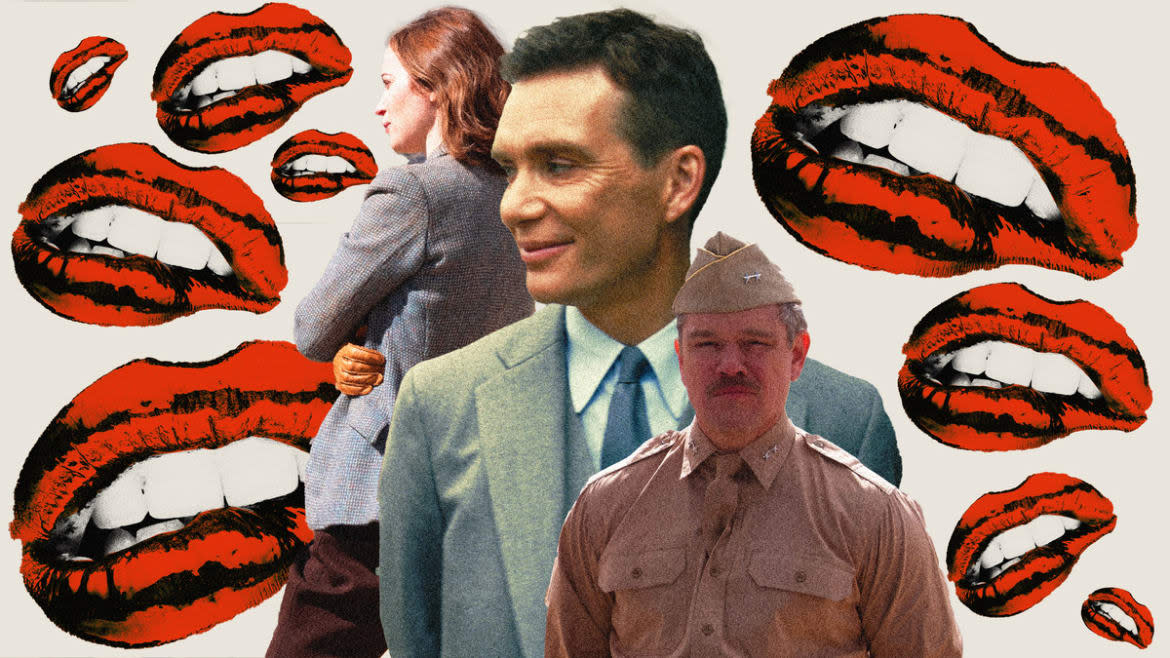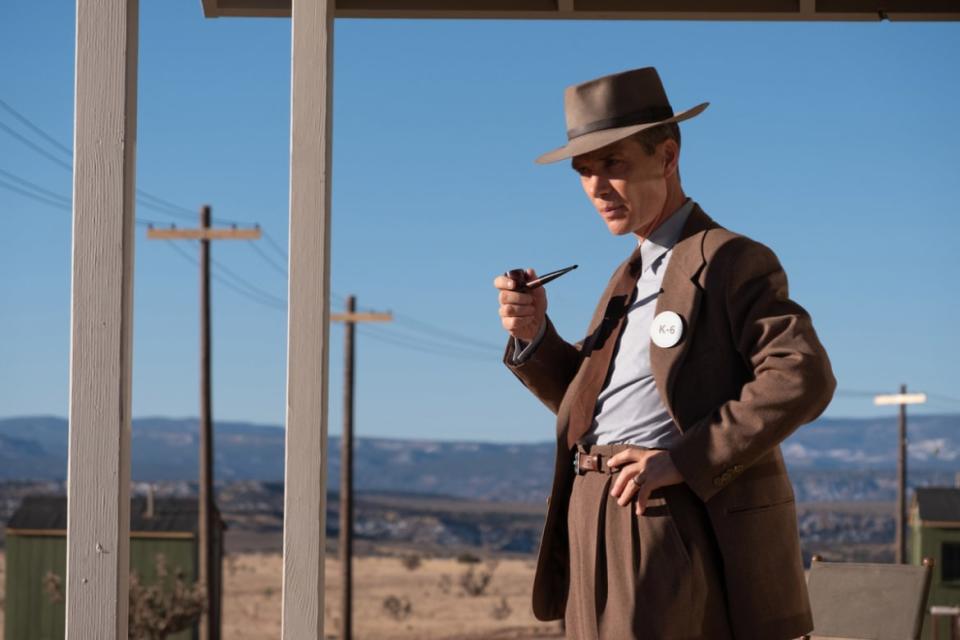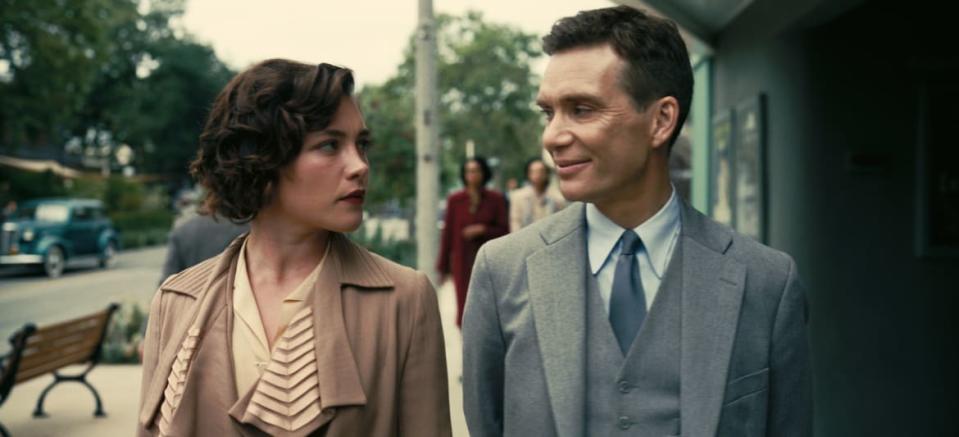The Biggest Problem With ‘Oppenheimer’: Everyone Is Too Damn Sexy

Scientific grunt work doesn’t render very well on the silver screen. But neither do most jobs, or for that matter, most people. When it comes to theoretical physicists and aesthetic appeal, it’s best to channel quantum mechanics and suspend your disbelief.
Enter Oppenheimer, where Brigadier General Matt Damon says things like, “This is the most important thing to ever happen in the history of the world!” And, “We’ve given them an ace. It’s up to them to play the hand.” No doubt these sentiments were actually delivered as 700-page memorandums, Pendaflex-foldered and date-stamped. But this is Hollywood we’re talking about. You’ll find little in the way of stationery here, at least not on screen. And when the occasional differential equation rolls into frame, writer/director Christopher Nolan cuts smartly away before the audience might nod off.
To Nolan’s credit, Oppenheimer is a terrifically researched film. But it’s a film nonetheless, and translating sprawling, decades-long military sagas via camera necessitates shortcuts. I’m not a vetted expert on nuclear history but I’ve dabbled, having acted as research assistant for a 2020 treatise on plutonium production. This is to say that I’m familiar with the players.
I know, for example, that Matt Damon is far too cuddly, good-looking, and agreeable to portray the irascible Leslie Groves, nicknamed “Greasy” by his fellow West Point cadets. I know that Niels Bohr, the Danish physicist with a famously soft, nigh-unintelligible voice, is misrepresented by Shakespearean enunciator Kenneth Branagh. Nolan’s rolodex runs deeper than Wes Anderson’s these days, and if there’s a gripe to be had with Oppenheimer, it’s that everyone involved is just too damned sexy.

But, again, this is Hollywood, and where Nolan leaves the beaten path of record he generally does so to sate our dopamine addiction. Come to think of it, I haven’t been inside an actual physics department in a while. Maybe the professors really are incredibly gorgeous.
“His blue eyes and his wild Einstein hair…”
Luckily for Nolan, the subject of his cinematic obsession was a high-cheeked academic anomaly. The poet Edith Jenkins, who overlapped with J. Robert Oppenheimer in leftwing circles, describes his “precocity and brilliance… his jerky walk, feet turned out, a Jewish Pan with his blue eyes and his wild Einstein hair.” Manhattan Project scientist Robert Wilson agrees, admitting that he was “caught up by the Oppenheimer charisma,” “his style, the poetic vision of what we were doing.”
No, Oppy’s jawline never approached the artful chisel of Cillian Murphy’s, but there are unmistakable parallels—a bit elfin, a bit skeletal—to be drawn. Certainly Oppenheimer availed himself of more mistresses than your average mid-century physicist. Nolan spends perhaps too much time focusing on one of them (Jean Tatlock, played by Florence Pugh) and mentions a second in passing (Ruth Tolman, a bit part Louise Lombard), while avoiding speculation of yet others, such as when Berkeley cops found grad student Melba Phillips sleeping in Oppy’s car somewhere in the Coastal Range, the professor himself suspiciously absent.
Oppenheimer’s messy personal life makes him an ideal candidate for exposé—look no further than Kai Bird and Martin J. Sherwin’s bestselling American Prometheus, Nolan’s source material. But here I’ll return to Hollywoodization, for it’s one thing to get wind of Oppenheimer’s foibles and quite another to see Florence Pugh writhing hallucinatorily on his lap during the 1954 AEC security hearings.
If Nolan goes too far in this film, if he stretches the Oppenheimer envelope past its roomy Pendaflex accommodations, it’s in the context of Oppy outside the Manhattan Project. Despite magnificent wartime subject matter—not all of which is touched upon—Nolan can’t quit his blockbuster tropes. Monochrome senate hearings, petty political twists (how is RDJ’s aide still employed?), Oppy’s fingers gracing Emily Blunt’s as she asks for a cocktail science primer.
Maybe audiences require such touchstones to contextualize the rest of the film. Nolan seems to think so. But as the string section swelled during a trite turn in the relatively forgettable career of Lewis Strauss, I found myself wishing we could’ve stayed put in New Mexico, on the high mesa that forms this film’s heart.
Nolan’s feat comes in recreating Los Alamos, a critical American moment with more than enough narrative to forgo some of the politico-romantic schlock that drags this thing to a three-hour runtime. Fascinated by character, by gray morality, Nolan found Oppy such an attractive case study that it nearly steered his magnum opus (I do think this film qualifies) off track. Each of the factual and immensely complicated bomb-related obstacles—for example, thunderstorms the morning of the Trinity Test—holds a world-changing thrall entirely separate from the whims of one man, no matter how chiseled his jaw.
“The biggest son-of-a-bitch I’ve ever met…”
Speaking of moralistic study, there’s one character who escapes Oppenheimer scot-free: Matt Damon’s overly fit and preposterously understated Leslie Groves. “I’ve known General Groves since I was 2nd lieutenant,” said the real-world David Nichols (cast as Dane DeHaan) in a 1965 interview. “To start off with, I would say he is the biggest son-of-a-bitch I’ve ever met, bar none.”
“Impatient, brusque, intolerant,” writes Robert S. Norris in his comprehensive Groves biography Racing for the Bomb. “He had few close friends, and others generally kept their distance.”
“When you looked at Captain Groves, a little alarm bell rang ‘Caution’ in your brain,” said a colleague.
Damon bulked up, lumped up—whatever—for his role as Nike executive Sonny Vaccaro in this year’s Air. But it’s a serious leap from office park Vaccaro to Army taskmaster Groves, who even in his 1970 New York Times obituary suffered the redundant label of, “a chunky, heavyset man, with a tendency toward paunchiness.” More unfounded than Damon’s weight, however, is a good guy nature cultivated over decades of Good Will Hunting television marathons, Invictus advertisements, and so on.
Cillian Murphy’s shell-shocked victory speech presents a nice commentary on the ethical morass of atomic weaponry. But Damon/Groves makes for an even juicier moralistic target, and he’s let off the hook with that aforementioned one-liner: “We’ve given them an ace, it’s up to them to play the hand.” If anyone bore responsibility for detonating two atomic bombs over civilian populations, it was General Leslie R. Groves, the only person playing said poker game in the first place.
Racing for the Bomb explains, “Groves, sitting atop his security pyramid, was the only person who knew everything about the bomb project—more than the chief of staff, more than the secretary of war, more than the president.” He was therefore “singularly concerned with the bomb, with getting it finished, tested, and used, and his superiors deferred to him time and again to make the choices that would make this happen.”
Nolan illustrates how the bomb haunted Oppenheimer. Groves, cinematically absent after Trinity, showed no such regret. Critiquing the general’s 1962 autobiography Now It Can Be Told, the Saturday Review wrote, “Groves is motivated by a simple and all-sufficing patriotism that is untroubled by what others see in the atom. He does not probe for any new vision of national interest in the age he helped create.”
Simple and all-sufficing patriotism—sounds familiar. Make of it what you will.
“Looked a bit like a country bumpkin…”
The only Oppenheimer character who comes across as legitimately malevolent is Benny Safdie’s terrific Ed Teller. Maybe I fell for Teller because Safdie, a director by trade, looks more like a physicist than a cologne model. Still, I get the sense that Safdie studied his source material. When he pipes up about the “Super”—the hydrogen bomb—his eyes hold nary a flicker of regret. And he keeps doing so despite repeated disdain from his colleagues.

Look, I get it, I really do, on the attractiveness quotient. This is a movie, and if scientists and bureaucrats don’t suffice for a visual study then we’ll goddamn pretend. It’s only sensible that Ernest Lawrence— who, per physicist Jeremy Bernstein, “looked a bit like a country bumpkin”—becomes Josh Hartnett. That Lewis Strauss, a crooked-toothed self-made paper pusher, turns into silver fox Robert Downey Jr. I guess I even understand why Olivia Thirlby got thrown in out of absolutely nowhere, probably as Lilli Hornig, though I can’t recall her name being said aloud.
Nolan had to beautify this stuff because the big screen is a beautiful place. He gets most of the issues absolutely right, and I’ll be pulling for him come Oscar season. I doubt I’ll wind up remembering Emily Blunt’s Kitty Oppenheimer, Matthew Modine’s Vannevar Bush, or whoever the hell Rami Malek was supposed to be. But I’ll surely remember the Trinity Test, fingers trembling over that big red button, “10-9-8” and the towering explosion and the pressure wave—even if, no shade at Nolan, David Lynch already did it better on television.
Keep obsessing! Sign up for the Daily Beast’s Obsessed newsletter and follow us on Facebook, Twitter, Instagram and TikTok.
Read more of our Oppenheimer coverage HERE.
Rami Malek’s Quiet Character Is the Secret Weapon of ‘Oppenheimer’
Was the ‘Barbie’ and ‘Oppenheimer’ Double Feature Worth It?
The ‘Oppenheimer’ Sex Scenes Are Cringey, But Not Because of the Sex
Get the Daily Beast's biggest scoops and scandals delivered right to your inbox. Sign up now.
Stay informed and gain unlimited access to the Daily Beast's unmatched reporting. Subscribe now.

 Yahoo News
Yahoo News 
